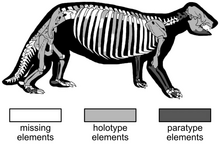Parocnus
Jump to navigation
Jump to search
| Parocnus Temporal range:
| |
|---|---|

| |
| Skeleton of Parocnus dominicanus | |
| Scientific classification | |
| Domain: | Eukaryota |
| Kingdom: | Animalia |
| Phylum: | Chordata |
| Class: | Mammalia |
| Order: | Pilosa |
| Family: | †Megalocnidae |
| Genus: | †Parocnus Miller 1929 |
| Species | |
|
See text | |

Parocnus is an extinct genus of sloth native to Cuba and Hispaniola, belonging to the family Megalocnidae. It was a terrestrial ground sloth, being the second largest Caribbean sloth after Megalocnus.[1]
Taxonomy
After[2]
- †Parocnus browni Pleistocene to Holocene, Cuba
- †Parocnus serus Pleistocene to Holocene, Hispaniola (synonym Megalocnus zile)[1]
- †Parocnus dominicanus Pleistocene to Holocene, Hispaniola[3]
References
- ^ a b McAfee, Robert K.; Beery, Sophia M. (2021-03-04). "Intraspecific variation of Megalonychid sloths from Hispaniola and the taxonomic implications". Historical Biology. 33 (3): 371–386. Bibcode:2021HBio...33..371M. doi:10.1080/08912963.2019.1618294. ISSN 0891-2963. S2CID 195403443.
- ^ White, J.L.; MacPhee, R.D.E. (2001). "The sloths of the West Indies: a systematic and phylogenetic review". In Woods, C. A.; Sergile, F. E. (eds.). Biogeography of the West Indies: Patterns and Perspectives. Boca Raton, London, New York, and Washington, D.C.: CRC Press. pp. 201–235. doi:10.1201/9781420039481-14. ISBN 978-0-8493-2001-9.
- ^ McAfee, Robert; Beery, Sophia; Rimoli, Renato; Almonte, Juan; Lehman, Phillip; Cooke, Siobhan (2021-08-31). "New species of the ground sloth Parocnus from the late Pleistocene-early Holocene of Hispaniola". Vertebrate Anatomy Morphology Palaeontology. 9 (1). doi:10.18435/vamp29369. ISSN 2292-1389.

